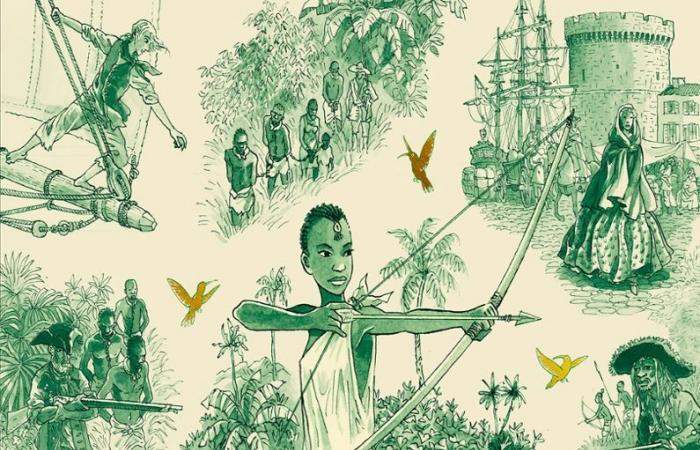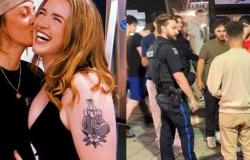This is without a doubt a book to slip into your suitcase, the third and final volume of a masterful saga (3 volumes of 1,312 pages, sold at 150,000 copies) signed Timothée de Fombelle (the father of To you Lolness).
Alma – Freedom takes us to the heart of the slave trade in the 18th century. It is also a quest for freedom, a global investigation, a revolution, the storming of the Bastille, a king who is beheaded and slaves who dream of freedom. Alma, This is the saga that must be read to understand this story from which we have always had only one point of view: that of the slave traders. Here, those who have been silenced finally find a voice.
More than a novel, this major author of children’s literature has written almost as a testimony to the slave trade.
We meet real historical figures
Central character: Alma, daughter of the imaginary African people the Oko, Alma is looking for her brother Lam, kidnapped by slave traders.. A crazy quest that takes him from Africa to Santo Domingo via the United States and France, his story crosses that of another, that of Amélie whose father was murdered and who tries against all odds to run her sugar cane plantation, to which is added an investigation to try to find a treasure stolen from Amélie’s father, a shipowner from La Rochelle.
If the story is fictional, all these characters will meet real characters from history, and experience pivotal moments: the storming of the Bastille, the revolt of the slaves of Saint Domingue…
Historical truths are also hidden in the details. Excerpt: “Lorenzo Le Couteulx looks at his own face in the glass door. He spreads the white powder. An elegant man uses half a kilo of flour a day for his hair and face. Enough to make a one-pound loaf that would feed a child. As he watches him go, Jean Saint-Ange tells himself that the world has not quite finished dying.”
Timothée de Fombelle explains to RTL: “I thought I had done my research at the beginning and that I would be able to write with my bare hands as I dream of doing at any time. Not to write simply with my imagination and what I know. But to tell the truth, On each page I open a new world that requires me to do more research. In the 3rd volume, at one point we talk about coffee culture. So I had to immerse myself in coffee culture manuals… In the same way that I had immersed myself in manuals, the Manual of the Gabier (the sailor’s bible) or the Manual of the sailor of the Hermione to understand and see how the people who sailed on these boats, these old rigs, carried out their maneuvers.”
Eye for detail
“Technical” details, and… historical truths: the storming of the Bastille or the death of Louis XVI and the appearance of historical figures such as the one nicknamed “the black Napoleon” Toussaint Louverture who led the revolt of the slaves of Saint Domingue which would end with the dismantling of this colony.
“I think it’s the effect of reality,” explains Timothée de Fombelle. “That is to say, if I want my characters to exist, the world around them must exist. I need these details, this useless detail (which seems useless) but which makes it exist. You also have to go into the tiny details, that of the noises of the city of Paris. When I place my characters on the corner of the rue des Blancs Manteaux, I ask myself the question: what exactly is happening at that moment? What is the noise of the herds going to the slaughterhouse on the rue du roi de Sicile next door? What is the noise of the bells that will be melted down during the entire decade following the Revolution. I notice on the maps of Paris that there are 50 churches, small bell towers, small chapels around. So I have to make these bells ring to make this world exist and then I just have to place my characters.”
A happy ending
After 2 volumes that kept the reader in suspense, Timothée de Fombelle opts (spoiler alert) for a “happy” ending. We won’t tell you how, but the ending is happy… or almost. Not all the characters will reach the end of the adventure completely unscathed.
“For a paradoxical reason,” explains the writer, “there is a lot of shadow in Alma’s journey and I had to be like an insect attracted to the light. That’s what guided me. I knew that in the end, there was, I say, Too bad for the spoiler, there was a reunion. It was something that meant a lot to me. It doesn’t say that everyone will arrive safely because it’s statistically impossible in this incredibly violent world of the 18th century. There’s something in the author and maybe even more in the French author. of books, of novels for young people: it’s the right to the miracle. I want to have the right to the miracle. Yes, Alma will reach the end of her journey and there will be a reunion.”
“When you finish an adventure,” the writer explains, “you have to close the doors you opened, you have to bring together all the threads you threw in the air like big spools. And everything has to fall back down and be tight. Keeping the rhythm, keeping the breath, without the slightly fabricated side of the endings. So there is something acrobatic, but there is the truth of the project from the start which made me feel like I couldn’t make a mistake.”
Alma- freedom Volume 3 is in bookstores. Slip it (them) into your suitcase this summer. This series of novels, this saga is a real success, like every story by Timothée de Fombelle. Let yourself be carried away and tempted by this saga which will forever mark children’s literature. Timothée de Fombelle wields words like no one else. Alma helps to grow, to believe in freedom and in life without ever suffering.
Read more






